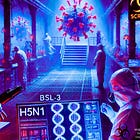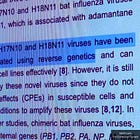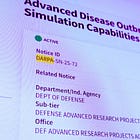NIH-Funded New York, Texas Labs Engineer Never-Before-Seen H5N1 Virus That Kills 100% of Mammals: Journal 'npj Vaccines'
NIH has spent nearly $60 million in taxpayer funds in a single contract backing bird flu experiments that produced synthetic constructs with full lethality in mammals.
A new peer-reviewed study reveals that scientists at the Texas Biomedical Research Institute and Mount Sinai’s Icahn School of Medicine have synthetically engineered a construct modeled on the avian influenza A (H5N1) strain said to be circulating in cattle in Texas in 2024.
The resulting sequence, which had not existed prior to the experiment, proved 100% lethal in mammals under laboratory conditions.
The lab-built strain, labeled HPhTX-Nluc, was assembled using a technique called reverse genetics, which allows researchers to reconstruct so-called viruses from digital sequence data.
Follow us on Instagram @realjonfleetwood & Twitter/X @JonMFleetwood.
If you value this reporting, consider upgrading to a paid subscription.
A NanoLuciferase (Nluc) reporter element was added to allow researchers to visualize exposure dynamics in real time.
When tested in mice, the construct triggered fatal outcomes in all unvaccinated animals within seven days.
“All of them succumbed to infection by days 6 and 7 after challenge,” the researchers wrote in the journal npj Vaccines.
This specific laboratory construct had not been observed in nature.
Its capacity to induce 100% mortality was brought about by the experiment.
The study also assessed a separate engineered construct, LPhTXdNS1, developed as a live attenuated vaccine.
Scientists removed a gene known as NS1—a segment said to help the so-called virus evade immune response—purportedly in order to weaken the sequence.
Yet even without NS1, the construct was still able to replicate in mammalian cells.
Specifically, it grew in Vero cells, which are mammalian kidney cells commonly used in labs that do not produce interferon.
This outcome suggests the engineered sequence retained functionality in mammalian systems despite the gene deletion.
In other words, researchers synthesized an H5N1-labeled construct that could persist in immune-deficient mammalian cells, even after removing the very gene said to make that possible.
Although the study is framed as vaccine research, the core activities involve creating novel, never-before-seen genetic sequences and testing them for their ability to trigger severe outcomes in mammals—outcomes attributed to what virologists classify as infection.
Funded by U.S. Taxpayers
The work was funded by the National Institute of Allergy and Infectious Diseases (NIAID), part of the NIH, under contract number 75N93021C00014.
The lead awardee of the contract is Dr. Adolfo Garcia-Sastre, a co-author of the study and professor at the Icahn School of Medicine at Mount Sinai.
According to federal grant records, this single contract has paid out at least $59,973,865 in taxpayer funds across multiple years to Mount Sinai for influenza and SARS-CoV-2 research projects involving Garcia-Sastre.
Background and Context
The source material, A/Texas/37/2024 (H5N1), is associated with a cattle-to-human transmission event—the first such reported case in the U.S. Since then, scientists have described additional mammalian adaptation markers in similar sequences.
Though researchers do not claim to have created a transmissible virus in the traditional sense, the practice of deleting, replacing, and combining genetic segments while testing them in mammals has drawn scrutiny for its similarity to what is often labeled gain-of-function work.
Many questions remain regarding the interpretation of these studies, especially among those who question the foundational assumptions of virology.
Regardless of one’s view on viral causation, the engineering of lethal biological constructs raises profound implications for biosafety and ethics.
Congress, the White House, the Department of Energy, the FBI, and the CIA acknowledged that a lab-related incident involving gain-of-function research is most likely the origin of COVID-19, raising concerns that ongoing experiments like these could trigger another pandemic.
The Texas/New York study ultimately presents LPhTXdNS1 as a potential vaccine.
But the facts remain: a previously non-existent genetic sequence was constructed in a lab, and when tested in mammals, it resulted in 100% fatal outcomes—all with funding from U.S. taxpayers.
Follow us on Instagram @realjonfleetwood & Twitter/X @JonMFleetwood.
If you value this reporting, consider upgrading to a paid subscription.
For advertising & sponsorship opportunities reaching 230,000+ monthly viewers, contact us by clicking below.











Not happy about this at all- but thank you so very much for bringing it to our attention!
Is this not considered gain of function! Where's Kennedy at on all this crap still being done. I can hear the laughter MAHAHAHA!
Linking as usual @https://nothingnewunderthesun2016.com/